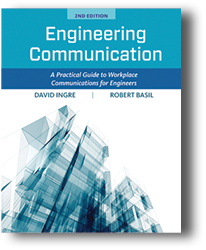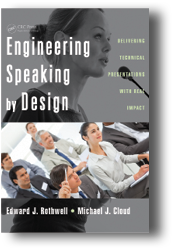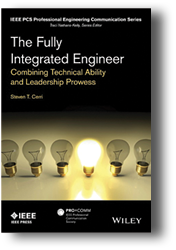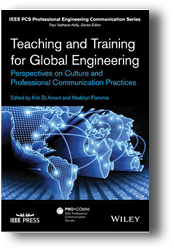Introduction
The books reviewed here range from conventional instruction in technical communications for non-engineers to topics applicable to engineers, such as the need to understand and practice engineering within a broader organizational and intercultural context. As such, these texts, taken together, can serve as a comprehensive curriculum specifically targeted at engineers, both as students and as professionals.
Engineering Communication: A Practical Guide to Workplace Communications for Engineers
 Engineering Communication: A Practical Guide to Workplace Communications for Engineers, by David Ingre and Robert Basil, is a comprehensive yet relatively compact introduction to the realities of communicating in engineering environments. The text emphasizes that communication, especially with non-technical audiences, is inescapable for the engineer and takes an increasing number of forms, including not only conventional genres like proposals and reports but also business plans, digital and social media, and online search methods.
Engineering Communication: A Practical Guide to Workplace Communications for Engineers, by David Ingre and Robert Basil, is a comprehensive yet relatively compact introduction to the realities of communicating in engineering environments. The text emphasizes that communication, especially with non-technical audiences, is inescapable for the engineer and takes an increasing number of forms, including not only conventional genres like proposals and reports but also business plans, digital and social media, and online search methods.
Through Cengage Learning’s online program, MindTap, instructors can customize and integrate content “seamlessly” with learning management systems like Blackboard. Students can take notes online, access videos of case studies, and listen to conversations enabling them to “examine and analyze oral forms of communication”—something typically not addressed in conventional texts (p. xiii).
The authors reflect the engineering perspective in a simple formula that specifies Context, Message, Audience, Purpose, and Product (CMAPP) as the criteria for achieving successful communication. This, in turn, can serve as the baseline for deriving situation-specific solutions, much as one can analyze the behavior of a particular electrical circuit from fundamental principles like Ohm’s law and Maxwell’s equations.
Thus, the communication process is described through Claude Shannon’s theory of information transfer, where noise or interference is identified as the variable to be eliminated from the communication. The authors explain how unnecessary words, poor grammar, cartoonish clip art, excessive verbal or visual complexity, and the failure to consider audience, context, and culture undermine communicative efficiency—in engineering terms, how noise undermines signal.
The emphasis on Context and Audience reflects the fundamental principle that engineering communication, unlike classroom writing, is “audience driven,” not “author driven” (p. 2, emphasis in original), and that failing to consider the audience profile is a major source of noise, along with failing to consider broader issues raised by intercultural communication, such as vocabulary, personal space, eye contact, and humor.
The text uses case studies from four sample organizations—a two-year technical college, a university with undergraduate and graduate engineering programs, and two companies founded by engineers—to model real-world communication problems. It also includes sections on persuasion, argumentation, syllogisms, and logical fallacies to provide engineers with fundamental reasoning skills useful when classroom knowledge falters and thinking critically from first principles is necessary.
Overall, Ingre and Basil have produced an excellent introduction to engineering communications. It combines fundamental, generic instruction in technical communication with an engineering-specific perspective and analytical approach that will appeal to the engineering student. This text is an excellent place to begin for an engineering communications curriculum.
Engineering Speaking By Design: Delivering Technical Presentations with Real Impact
 For deeper, more detailed instruction in presentation skills for engineers, Edward J. Rothwell and Michael J. Cloud’s Engineering Speaking by Design: Delivering Technical Presentations with Real Impact would be an outstanding choice. The authors explicitly inform students that presentations are unavoidable in engineering and often pivotal in securing funding or support for a project—the best technical ideas don’t necessarily get funded, but “those that are presented the best” do (p. 4, emphasis in original).
For deeper, more detailed instruction in presentation skills for engineers, Edward J. Rothwell and Michael J. Cloud’s Engineering Speaking by Design: Delivering Technical Presentations with Real Impact would be an outstanding choice. The authors explicitly inform students that presentations are unavoidable in engineering and often pivotal in securing funding or support for a project—the best technical ideas don’t necessarily get funded, but “those that are presented the best” do (p. 4, emphasis in original).
Rothwell and Cloud approach technical presentation as a problem in engineering design that can be specified and measured, and thus as a skill that can be learned and improved through practice, much like a musical performance. Concurrent presentation design is preferred because it emphasizes recursively “getting information and early feedback” (p. 16) and adjusting the presentation accordingly. In a successful presentation, as in “successful engineering design, form must match intended function” (p. 18), so the engineer “must keep the backgrounds, needs, and purposes of the audience firmly in mind at all times” (p. 17, emphasis in original).
Presenters should design the presentation to ensure it stays within the time limit, be ready to cope with balky equipment and, above all, practice. The presentation is structured as a two-part funnel, with the introduction leading to specific discussion in the body and then funneling back out through the conclusion. The presenter must state explicitly what real-world problem the technology solves before launching into a discussion of technical detail.
Especially appropriate to engineers is instruction on how to discern formal and informal logical fallacies; how to present calculations, not by reading them, but by substituting broader terms for mathematical notations described; how to test them for accuracy; and how to incorporate judgment into logic by using “Ockham’s razor” (pp. 45–66, 67). Similar but briefer advice is given on syntax and diction, the authors referring the student to their companion volume, Engineering Writing by Design: Creating Formal Documents of Lasting Value for a fuller treatment.
The remainder of the book covers slide design based on the principle that “Slides are visual aids,” and may even be unnecessary (p. 80), but if used, must be guided by “readability and complexity” (p. 90, emphasis in original). Presenters should avoid too many words or equations on slides (unless demanded by the audience) and should test their slides’ readability from far corners of the room. Above all, engineers should practice their presentation before groups and integrate their feedback.
Engineering Speaking by Design offers excellent practical advice aimed specifically at the engineer and not readily available in conventional technical communication textbooks. It shows the engineer how to think about presentations “as an engineering problem, and solve it” through a design approach focused on meeting the specifications or requirements of the talk (p. 3). As such, the book practices what it preaches, ably adjusting its content and format to the engineer, its target audience.
The Fully Integrated Engineer: Combining Technical Ability and Leadership Prowess
 Steven T. Cerri’s The Fully Integrated Engineer: Combining Technical Ability and Leadership Prowess extends the engineer’s understanding of audience and context more broadly into issues of career advancement and professional growth. Technology alone will not make engineers successful over the long term. Instead, a “phase shift” in their thinking is required—particularly the ability and willingness “to embrace ambiguity and the lack of a precise, right answer to all questions and problems” (p. 2, emphasis in original).
Steven T. Cerri’s The Fully Integrated Engineer: Combining Technical Ability and Leadership Prowess extends the engineer’s understanding of audience and context more broadly into issues of career advancement and professional growth. Technology alone will not make engineers successful over the long term. Instead, a “phase shift” in their thinking is required—particularly the ability and willingness “to embrace ambiguity and the lack of a precise, right answer to all questions and problems” (p. 2, emphasis in original).
This phase shift occurs by recognizing the behavioral sub-routines that influence our decisions and actions, and recontextualizing them within a new paradigm Cerri calls a Gem of Wisdom. He outlines a Cycle of Influence that begins with a Map of the World, a preconceived notion of how things are that Limits Our Beliefs by including some details but not others. This narrowed Focus of Attention triggers an Emotional and Physiological Charge, causing Actions and Behaviors that reinforce our original Map of the World.
The Cycle of Influence affects engineers as much as anyone else, despite their penchant for trying to understand everything through data and logic. To become successful in their careers, engineers must re-program their Cycle of Influence by enlarging their Map of the World, because only that can change the Actions and Behaviors at the end of the cycle. Change the Map, change the Behavior (pp. 27–29).
With this as his model, Cerri describes fifteen Limiting Beliefs that restrict the engineer’s career. The “goal is not to remove [the engineer’s] limiting belief,” but to “add choices” (p. 41). Cerri’s process shows the engineer how to rethink his or her Map of the World by adding new beliefs and noting the change in emotion or physiological response that accompanies them. As Cerri notes, this part of the process involves some heuristics and trial-and-error—it is not a precise recipe. Adding new beliefs will, over time, modify the actions and behaviors resulting from the previous Map of the World, while retaining the old belief, because it may actually be the “appropriate course of action” in some situations (p. 44).
Thus, engineers might have a Career-Limiting Belief that since their ideas are their identities, they must always fight for their ideas, because objections to them are essentially a “personal attack” (p. 45). Cerri shows how an engineer taking a broader view of the issue—which is not to be right but to solve the problem—invites others to participate in the problem solving process itself and lessens the sense of obligation the engineer has to be right all the time, unblocking the Limiting Belief and increasing the engineer’s value to the organization.
Using case studies, Cerri shows how the process can undo many Career-Limiting Beliefs that beset the engineer, such as Pursuing Perfection or Withholding Expertise. An interesting “self-help” book that can help engineers overcome the restrictions of a purely technological focus in their careers.
Teaching and Training for Global Engineering: Perspectives on Culture and Professional Communication Practices
 Kirk St.Amant and Madelyn Flammia’s Teaching and Training for Global Engineering: Perspectives on Culture and Professional Communication Practices is a collection of scholarly articles addressing how the engineer can communicate effectively in a global environment characterized by varying cultural expectations at the linguistic, societal, informational, and educational levels. Each article includes “foundational” information on the topic and “approaches to teaching these topics effectively” (p. xxx).
Kirk St.Amant and Madelyn Flammia’s Teaching and Training for Global Engineering: Perspectives on Culture and Professional Communication Practices is a collection of scholarly articles addressing how the engineer can communicate effectively in a global environment characterized by varying cultural expectations at the linguistic, societal, informational, and educational levels. Each article includes “foundational” information on the topic and “approaches to teaching these topics effectively” (p. xxx).
In general, engineers do not learn foreign languages, do not understand the socio-cultural influence of language, and are unaware of non-verbal cultural differences such as differing attitudes towards tight versus loose personal space, direct versus indirect speech, and holistic versus analytical reasoning. Even graphics, often considered universal in meaning, are influenced by cultural differences. German mechanics prefer highly detailed, bottom-up technical illustrations of transmission assembly, whereas Chinese mechanics, working on the same transmission, prefer less detailed, top-down drawings letting them fill in the details.
Similarly, social differences influence the willingness to equip desktops with open-source Linux (common in Europe and developing countries) rather than proprietary Microsoft (the American preference). Variations in brand preference reflect variations in localization strategies, leading to glocalization, a hybrid approach that integrates cultural differences more explicitly into the seemingly straightforward process of translation. A systematic value analysis method helps students discern the appropriate ethical parameters for intercultural communication through a flowchart designed to “resolve conflict in favor of the higher or more central value” within a set of competing values (p. 116).
Students can also learn and practice intercultural communication by working with students from other countries in virtual teams to design and publish technical documents and presentations. Particularly relevant to cross-cultural project communication is sensitivity to the centrality of experience and narrative in learning. Students learn “by doing and reflecting on doing” in “real-world, international situations,” like those experienced by practicing engineers (pp. 173, 176). Narratives are vital because they incorporate heuristics and ambiguity, requiring an interpretive approach that complements and culturally contextualizes the classical functionalist or quantitative method that assumes an underlying, universal truth untouched by cultural difference.
Teaching and Training for Global Engineering concludes with methods for “the assessment of intercultural learning outcomes,” assessment examples from Georgia Tech and Purdue, and a checklist for conducting an assessment. In all, the editors have compiled a useful selection of research articles enhanced by practical guidelines and techniques directly applicable to teaching.
Conclusion
Overall, the four books reviewed here offer the instructor the option of selecting one or more books to fit a particular curriculum or adopting all four as the basis for a comprehensive course that addresses not only the processes and tools of engineering communication but also the broader career, social, and cultural aspects of the profession. All engineering communications instructors can benefit from adopting and using any or all of these texts as befits their curriculum and pedagogy.
References
Cerri, Steven T. 2016. The Fully Integrated Engineer: Combining Technical Ability and Leadership Prowess. Hoboken, NJ: John Wiley & Sons, Inc. [ISBN 978-118-85431-0. 183 pages, including index. US$49.95 (softcover).]
Ingre, David, and Robert Basil. 2016. Engineering Communication: A Practical Guide to Workplace Communications for Engineers, 2nd ed. Boston, MA: Cengage Learning. [ISBN 978-1-305-63510-4. 318 pages, including index. US$95.95 (softcover).]
Rothwell, Edward J., and Michael J. Cloud. 2016. Engineering Speaking by Design: Delivering Technical Presentations with Real Impact. Boca Raton, FL: Taylor & Francis Group. [ISBN 978-1-4987-0577-6. 152 pages, including index. US$49.95 (softcover).]
St.Amant, Kirk, and Madelyn Flammia. 2016. Teaching and Training for Global Engineering: Perspectives on Culture and Professional Communication Practices. Hoboken, NJ: John Wiley & Sons, Inc. [ISBN 978-118-32802-6. 274 pages, including index. US$49.95 (softcover).]
About the Author
Donald R. Riccomini is an STC member and a senior lecturer in English at Santa Clara University, where he specializes in teaching engineering and technical communications. He previously spent twenty-three years in high technology as a technical writer, engineer, and manager in semiconductors, instrumentation, and server development.
Table 1. Books on engineering communications
| The Fully Integrated Engineer | Engineering Communications | Engineering Speaking by Design | Teaching and Training Global Engineering | |
|---|---|---|---|---|
| Audience | Engineering students and professionals | Engineering students | Engineering students | Engineering communications instructors, professionals, and managers |
| Major Strengths |
|
|
|
|
| Major Weaknesses | None, though “self-help” tone might put off some engineers | None, other than awkward physical size (8”x10”) | None. Only basic guidance on slide design. | None, except for occasionally wordy academic jargon |
| Comments | A practical approach for accelerating and expanding career growth, usable in classrooms or on the job, with online resources by the author available for further study and research. | A comprehensive introduction to technical communications with a definite engineering orientation. Provides underlying theoretical or research basis for guidance on communication model, and language. | Excellent handbook for improving the engineer’s speaking and presentation abilities, specifically written for engineers by engineers. | A very good source of research for instructors integrating intercultural communication awareness and techniques into the engineering communications curriculum. |
| Rating (5-star scale) | 4.5 | 4.5 | 5 | 4.5 |
| Cost (USD) | $49.95 | $95.95 | $49.95 | $49.95 |

